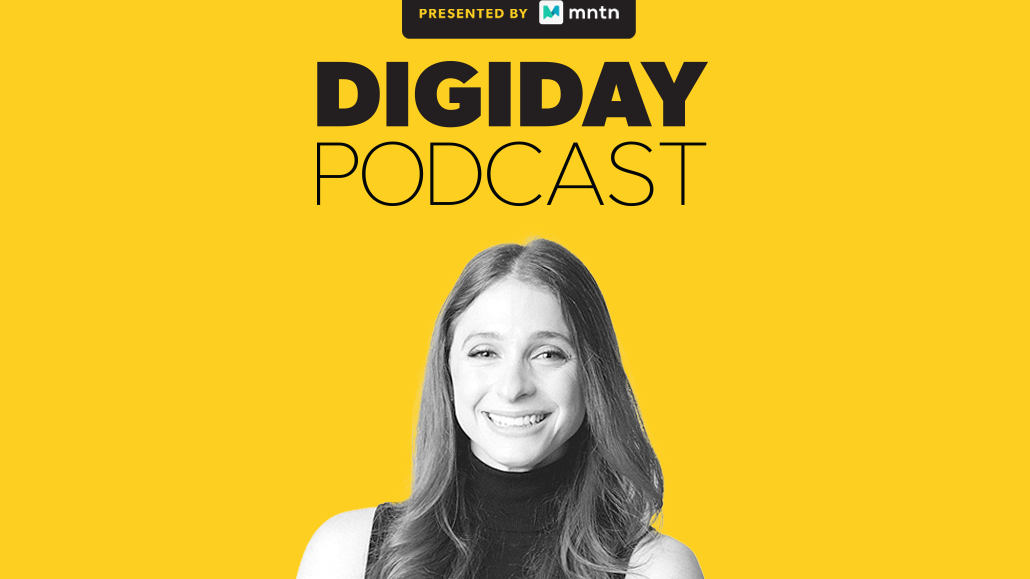Why Semafor’s CRO Rachel Oppenheim is putting clients first while building an entirely ad-based revenue model

Subscribe: Apple Podcasts • Spotify
Semafor launched on Oct. 18 with a business model that’s entirely reliant on direct-sold advertising and event sponsorship revenue – a risky business in some eyes during the current economic climate.
But the company’s founding CRO Rachel Oppenheim is confident that her team’s client-centric approach, which prioritizes “innovative” branded content and running ads against “experimental” editorial products, will be the wind in Semafor’s sails, she said on the latest episode of the Digiday Podcast.
Not only that, but focusing on the pockets of advertisers’ budgets that are directed to corporate reputation building will help insulate the company from the ebbs and flows of consumer and product advertising, which for now, is not a priority in the sales team’s selling strategy. Programmatic is also not a part of Semafor’s advertising mix, once again, preferring to build relationships with clients that are hopefully long term, according to Oppenheim.
While having launched with partners like Verizon, Mastercard and Pfizer, Semafor recently came under criticism for having gasoline manufacturer and distributor Chevron as an advertiser on the company’s Climate newsletter in its second week, to which many criticized as tone deaf and irresponsible in the coverage of climate change.
Oppenheim said post-interview in an email to Digiday that “advertisers have no bearing on our editorial coverage and we maintain a strict separation between news and third-party advertisement.”
Below are highlights of the conversation, which have been lightly edited and condensed for clarity:
Creating a modern media revenue team
[There is a trend toward] orchestration amongst many different revenue streams that can ultimately fuel and feed each other. Having a really strong and healthy subscriber revenue business can fuel your advertising business; [it] can fuel your licensing business; [it] can fuel your events business. These are all different components in the same machine.
Even single revenue streams are becoming so much more cross functional and so much more interconnected and interdependent. We need to be able to coordinate with our design teams, our product teams, our audience development teams, our [communications] and PR teams all to pull off really creative, integrated programs and partnerships.
One of the superpowers of starting from scratch is being able to design a media company with cross-functional work as a bedrock of how we work, because we’re not in a world anymore, where the advertising team exists as a silo. That was another huge selling point for me of being able to come [to Semafor]. I am so clear eyed about the direction we need to go and how we need to better serve our readers, our clients, all of our different stakeholders, but it takes a very different way of working.
Relying on advertising during an economic downturn
We haven’t had to change our strategy at all, [but] I think we’ve made a couple of smart, prioritization calls about where we want to invest. Overarching[ly] we’re sensitive to it, we’re following the ad market really, really closely, but there are a couple of things that are actually insulating Semafor and have represented wind in our sails.
We’re really focused on B2B and corporate reputation advertising. I think the audiences that we’re trying to build around represent influential, opinion leader audiences in the U.S. and around the world. Across every industry and category that we’ve been engaged with from an advertiser and partnership perspective, they’re under a lot of pressure from an economic perspective, but they’re also under a lot of pressure to drive positive brand reputation to engage critical stakeholders and to reach audiences in new ways. I think everybody is really, really honed in on the fact that innovation is a necessity in this media landscape, placing bets on new partners experimenting, you know, drilling into new platforms is incredibly important.
Going beyond traditional advertising placements
[Advertiser Hyundai] Genesis is a great example where we’re working with them across platforms, from our email newsletters to our video journalism. And we’re also working with them across premium advertising. But the real I think crown jewel in the relationship is that many of Semafor’s Newsmaker events are going to be taking place at Genesis House in New York City. We really wanted to think in a non-traditional way about how we can marry our strengths with Genesis in order to create something that’s of high value for their brand for their audiences – really to be able to combine and conquer in new ways.
More in Media

Here are the biggest moments in AI for publishers in 2025
Here are some of the moments that defined how publishers adapted to the AI era this year.

Digiday+ Research roundup: Gen Z news consumption and diversification in the DSP space were 2025’s top trends
As 2025 winds down, we rounded up the biggest trends of the year, based on the data that resonated the most with Digiday’s readers.

What publishers are wishing for this holiday season: End AI scraping and determine AI-powered audience value
Publishers want a fair, structured, regulated AI environment and they also want to define what the next decade of audience metrics looks like.








